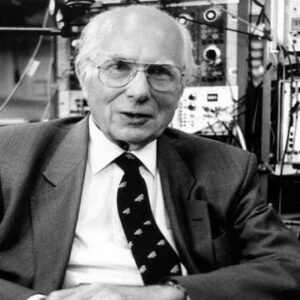Sir Andrew Fielding Huxley was a physiologist, biophysicist, mathematician, and mechanical genius from the United Kingdom. He was awarded the Nobel Prize in Physiology or Medicine for demonstrating how nerve cells generate electrical impulses to regulate the perceptions and functions of the human body. Sir Alan Hodgkin, a British scientist and his old professor, and Sir John Eccles, an Australian biophysicist, shared this award. Huxley and Hodgkin’s investigations helped to understand the effects of anesthesia on the human body and the identification of numerous hereditary disorders. Their efforts also contributed to the design of artificial hands, arms, legs, and feet. Huxley and Hodgkin showed how an electrical impulse passes from one end of a nerve cell to the other, whereas Eccles described how the impulse is transmitted from one cell to the next. By tapping a dead frog’s limb with an electrical current, an Italian physicist was able to answer an age-old enigma. They utilized a nerve cell from a squid referred as a “giant axion,” which is the largest nerve cell identified in any living thing. They successfully implanted microelectrodes into the nerve cell and recorded the potential difference between its two ends when an electric current was sent through it.
Youth and Early Life
Sir Andrew Huxley was born on November 22, 1917, in Hampstead, north London. His father was a writer and editor, Leonard Huxley, and his mother Rosalind Bruce.
He was the younger of Leonard and Rosalind’s two children. His older sibling was named David.
Julian Huxley, an animal behavior scientist, and Aldous Huxley, a novelist, were his half-brothers from his father’s first marriage.
Both of his half-brothers were older than he was and had minimal impact on his career. Aldous was 23 years old and Julian was 30 years old when Andrew was born.
His parents gave him a lathe when he was 14 because he was technically adept from an early age. He left the lathe intact and later utilized it to construct a variety of apparatus for his studies.
After his father passed away when he was 15 years old, his mother urged him to study physics because he had an aptitude for all things mechanical.
From 1925 to 1930, he attended the University College School, and from 1930 to 1935, he attended the Westminster School. Here, he was awarded a scholarship for graduate school.
In 1935, he enrolled at Cambridge University’s Trinity College to study engineering and physics but switched to physiology, which he had studied as an elective.
He studied anatomy from 1937 to 1938 with the intent of becoming a physician.
In 1938, he earned a bachelor’s degree in physiology, followed by a master’s degree in 1945.
Andrew Huxley’s Career
In the summer of 1939, he began working with Professor Alan Hodgkin at the Marine Biological Laboratory in Plymouth, England on squid axons.
When the Second World War broke out with the German invasion of Poland in September 1939, he was forced to abandon his experiments and join the war effort.
He was hired by the ‘British Anti-Aircraft Command’ to work on the development of antiaircraft gun-controlling radar.
He was subsequently transferred to the Admiralty, where he performed the same duties for anti-aircraft guns deployed on warships. During this time, he assisted Hodgkin in developing a new gunsight.
In 1946, following the conclusion of World War II, he began his studies with Professor Alan Hodgkin and taught at the ‘Department of Physiology’, despite having received a research grant from Trinity College in 1941.
He conducted studies with Hodgkin between 1946 and 1951.
In 1952, Huxley and Hodgkin published their findings.
After 1952, his study focused on the conduction of electric current in muscles.
He was the editor of the ‘Journal of Physiology and the ‘Journal of Molecular Biology’ from 1950 to 1957.
In 1953, he was employed at “Woods Hole” in Massachusetts, United States.
In 1959, he presented lectures at the Johns Hopkins Medical School.
After being selected as a “Jordell Professor,” he was appointed professor and head of the department of physiology at the “University College” in London in 1960. He held this position until 1983.
In 1961, he participated in an exchange program between Russian and British teachers and delivered Neurophysiology courses at the Kyiv University.
He delivered lectures at Columbia University in 1964.
In 1969, he was appointed Royal Society Research Professor at the Department of Physiology at University College London.
From 1976 to 1977, he served as president of the British Association for the Advancement of Science.
In 1983, he defended the decision of the “Royal Society” to elect Margaret Thatcher as a fellow over the protests of 44 individuals.
In 1984, he was appointed master of Trinity College, a position he held until 1990.
From 1980 to 1985, he served as the President of the “Royal Society.”
From 1986 until 1993, he served as president of the International Union of Physiological Sciences.
Awards & Achievements
In 1955, Sir Andrew Huxley became a Fellow of the Royal Society.
In 1963, he was awarded the Nobel Prize in Physiology or Medicine.
In 1974, he was given the knighthood.
In 1983, he was awarded the “Order of Merit.”
Personal History and Legacy
In 1947, he wed Jocelyn Richenda Gammell Pease, with whom he had Stewart and five daughters, Janet, Camilla, Eleanor, Henrietta, and Clare.
Sir Andrew Huxley passed away on May 30, 2012, due to cancer.
Estimated Net Worth
Neuroscientists, biophysicists, physicists, physiologists, and physicians are Andrew Huxley’s primary sources of income. His estimated net worth is $5 million. We lack sufficient evidence regarding Andrew Huxley’s automobiles and lifestyle.


